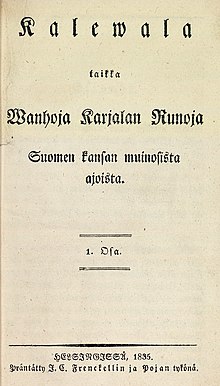
Back Kalevala Afrikaans كاليفالا Arabic Kalevala Azerbaijani Калевала Bashkir Калевала Byelorussian Калевала BE-X-OLD Калевала Bulgarian Kalevala Breton Kalevala Catalan Kalevala Czech
 Kalevala. The Finnish national epic by Elias Lönnrot. First edition, 1835. | |
| Author | Elias Lönnrot |
|---|---|
| Original title | Kalevala (or Kalewala, first edition, 1835) |
| Translator | |
| Country | Grand Duchy of Finland |
| Language | Finnish |
| Genre | |
| Publisher | J. C. Frenckell ja Poika, among others |
Publication date |
|
Published in English |
|
| Pages |
|
| 894.5411 | |
| LC Class | PH324 .E5 |
Original text | Kalevala (or Kalewala, first edition, 1835) at Finnish Wikisource |
| Translation | Kalevala at Wikisource |
The Kalevala (IPA: [ˈkɑleʋɑlɑ]) is a 19th-century compilation of epic poetry, compiled by Elias Lönnrot from Karelian and Finnish oral folklore and mythology,[1] telling an epic story about the Creation of the Earth, describing the controversies and retaliatory voyages between the peoples of the land of Kalevala called Väinölä and the land of Pohjola and their various protagonists and antagonists, as well as the construction and robbery of the epic mythical wealth-making machine Sampo.[2]
The Kalevala is regarded as the national epic of Karelia and Finland[Note 1] and is one of the most significant works of Finnish literature with J. L. Runeberg's The Tales of Ensign Stål and Aleksis Kivi's The Seven Brothers.[4][5][6] The Kalevala was instrumental in the development of the Finnish national identity and the intensification of Finland's language strife that ultimately led to Finland's independence from Russia in 1917.[7][8] The work is known internationally and has partly influenced, for example, J. R. R. Tolkien's legendarium (i.e. Middle-earth mythology).[9][10]
The title "Kalevala" refers to Kaleva, also known as Kalevi or Kalev. Kaleva, and his sons are important heroic figures in Estonian, Finnish and Karelian mythology. In the Finnish epic Kalevala, he is an ancient Finnish ruler. Hence, the Finnish word "Kalevala" means "land of heroes".[citation needed]
The first version of the Kalevala, called the Old Kalevala, was published in 1835, consisting of 12,078 verses. The version most commonly known today was first published in 1849 and consists of 22,795 verses, divided into fifty folk stories (Finnish: runot).[11] An abridged version, containing all fifty poems but just 9732 verses, was published in 1862.[12] In connection with the Kalevala, there is another much more lyrical collection of poems, also compiled by Lönnrot, called Kanteletar from 1840, which is mostly seen as a "sister collection" of the Kalevala.[13]
- ^ Asplund, Anneli; Sirkka-Liisa Mettom (October 2000). "Kalevala: the Finnish national epic". Archived from the original on 23 November 2010. Retrieved 15 August 2010.
- ^ Kalevala, the national epic of Finland – Finnwards
- ^ Tolkien, J.R.R. (2015). "On 'The Kalevala' or Land of Heroes". In Flieger, Verlyn (ed.). The Story of Kullervo (1st US ed.). Boston: Houghton Mifflin Harcourt. p. 70. ISBN 978-0-544-70626-2.
- ^ Kansalliskirjailija on kansakunnan peili (in Finnish)
- ^ Tosi ja taru Vänrikki Stoolin tarinoissa (in Finnish)
- ^ Suomalaiset klassikkokirjat – Oletko lukenut näitä 10 kirjaa? Archived 7 December 2023 at the Wayback Machine (in Finnish)
- ^ Vento, Urpo. "The Role of The Kalevala" (PDF). Archived from the original (PDF) on 16 July 2011. Retrieved 17 August 2010.
- ^ William A. Wilson (1975) "The Kalevala and Finnish Politics" Journal of the Folklore Institute 12(2/3): pp. 131–55
- ^ Carpenter, Humphrey, ed. (1981). The Letters of J. R. R. Tolkien. Houghton Mifflin. ISBN 0-395-31555-7.
- ^ Sander, Hannah (27 August 2015). "Kullervo: Tolkien's fascination with Finland". BBC News. Retrieved 16 September 2022.
- ^ Kalevala Society. "Kalevala, the national epic". Archived from the original on 23 March 2010. Retrieved 15 August 2010.
- ^ "The Project Gutenberg EBook of Kalevala (1862)". www.gutenberg.org. Retrieved 6 December 2020.[permanent dead link]
- ^ Bosley, Keith (March 2000). "Finland's Other Epic: The Kanteletar". thisisFINLAND. Retrieved 5 November 2021.
Cite error: There are <ref group=Note> tags on this page, but the references will not show without a {{reflist|group=Note}} template (see the help page).
© MMXXIII Rich X Search. We shall prevail. All rights reserved. Rich X Search